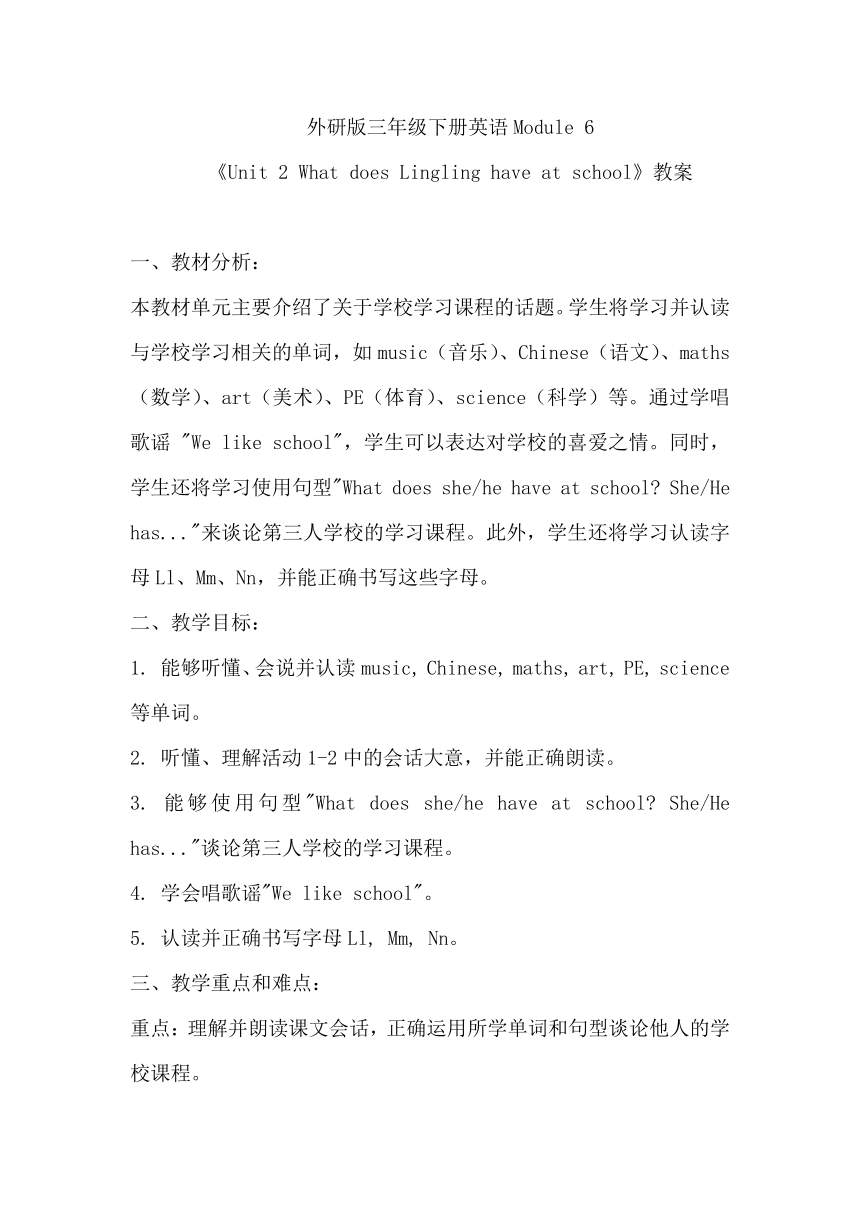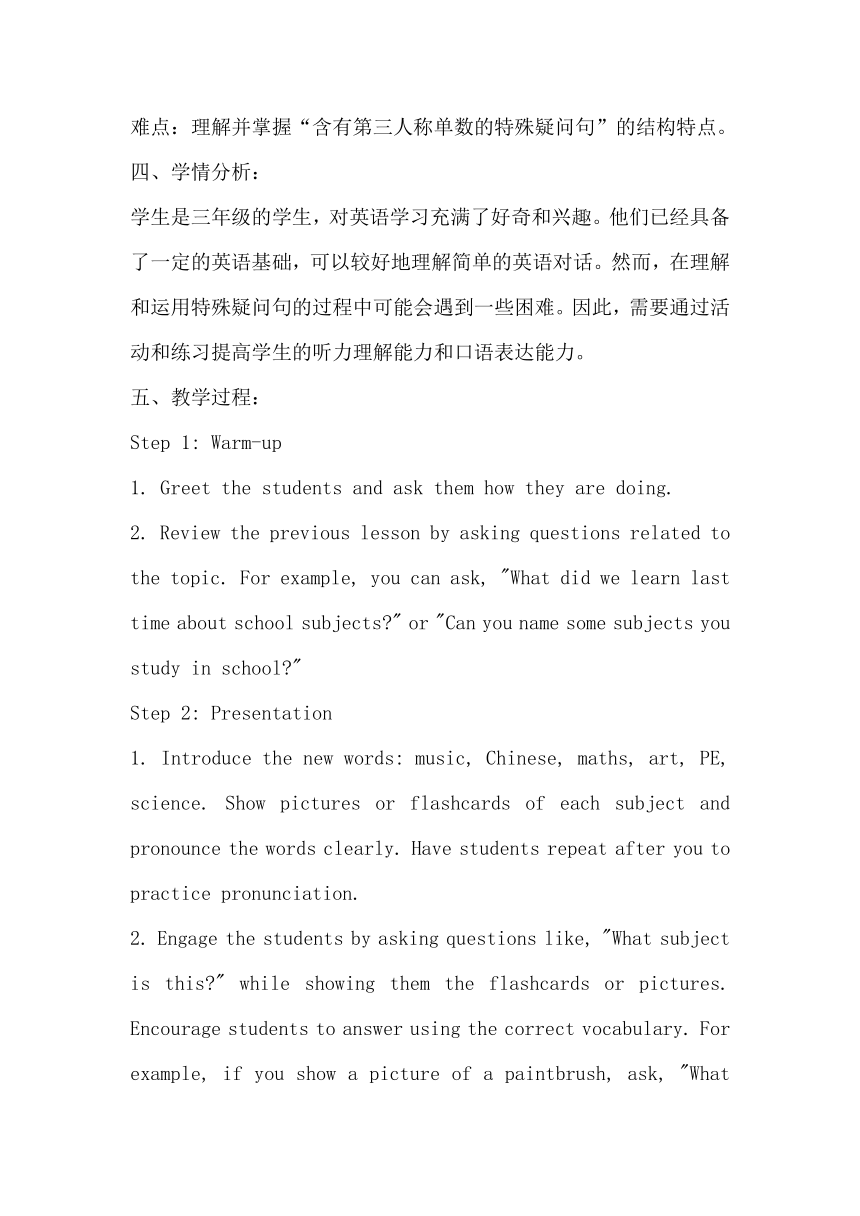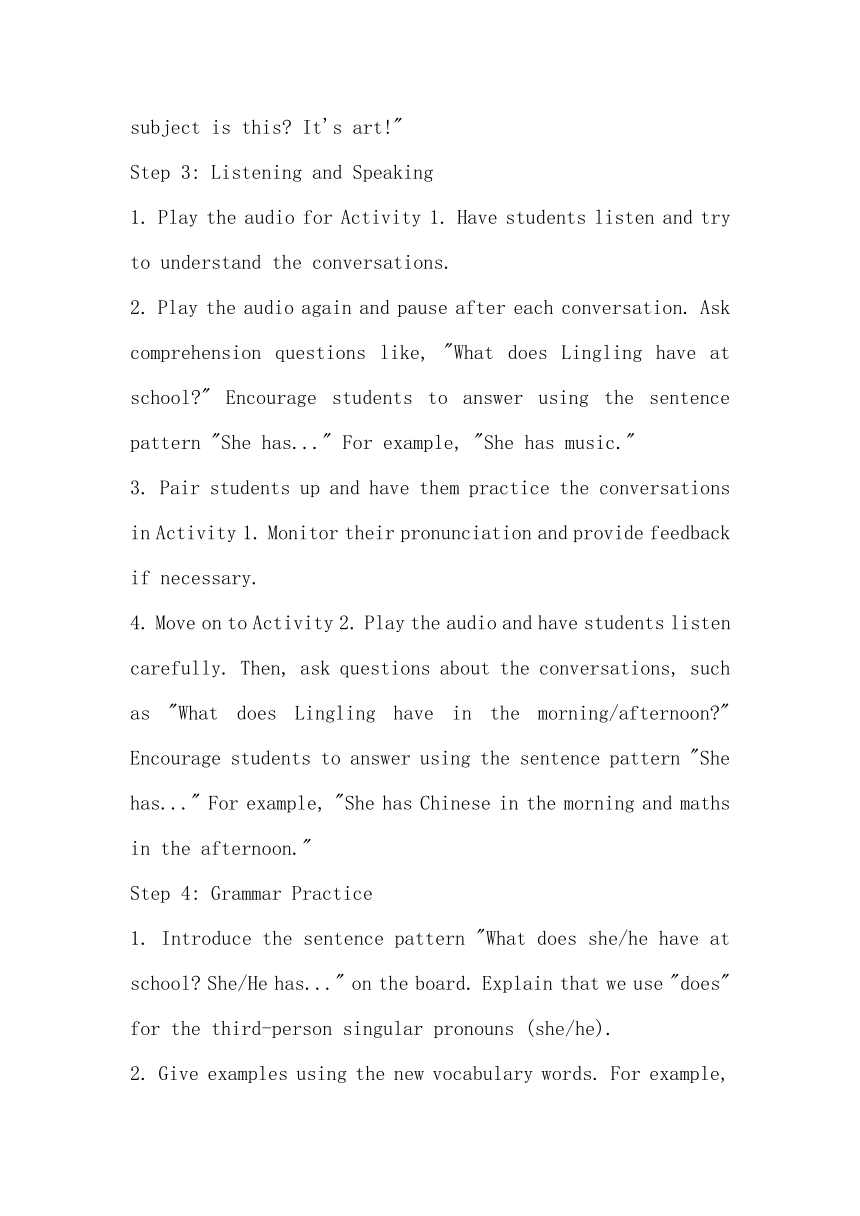Module 6 Unit 2 What does Lingling have at school 教案含反思
文档属性
| 名称 | Module 6 Unit 2 What does Lingling have at school 教案含反思 |

|
|
| 格式 | docx | ||
| 文件大小 | 13.6KB | ||
| 资源类型 | 教案 | ||
| 版本资源 | 外研版(三年级起点) | ||
| 科目 | 英语 | ||
| 更新时间 | 2024-02-03 19:45:31 | ||
图片预览



文档简介
外研版三年级下册英语Module 6
《Unit 2 What does Lingling have at school》教案
一、教材分析:
本教材单元主要介绍了关于学校学习课程的话题。学生将学习并认读与学校学习相关的单词,如music(音乐)、Chinese(语文)、maths(数学)、art(美术)、PE(体育)、science(科学)等。通过学唱歌谣 "We like school",学生可以表达对学校的喜爱之情。同时,学生还将学习使用句型"What does she/he have at school She/He has..."来谈论第三人学校的学习课程。此外,学生还将学习认读字母Ll、Mm、Nn,并能正确书写这些字母。
二、教学目标:
1. 能够听懂、会说并认读music, Chinese, maths, art, PE, science等单词。
2. 听懂、理解活动1-2中的会话大意,并能正确朗读。
3. 能够使用句型"What does she/he have at school She/He has..."谈论第三人学校的学习课程。
4. 学会唱歌谣"We like school"。
5. 认读并正确书写字母Ll, Mm, Nn。
三、教学重点和难点:
重点:理解并朗读课文会话,正确运用所学单词和句型谈论他人的学校课程。
难点:理解并掌握“含有第三人称单数的特殊疑问句”的结构特点。
四、学情分析:
学生是三年级的学生,对英语学习充满了好奇和兴趣。他们已经具备了一定的英语基础,可以较好地理解简单的英语对话。然而,在理解和运用特殊疑问句的过程中可能会遇到一些困难。因此,需要通过活动和练习提高学生的听力理解能力和口语表达能力。
五、教学过程:
Step 1: Warm-up
1. Greet the students and ask them how they are doing.
2. Review the previous lesson by asking questions related to the topic. For example, you can ask, "What did we learn last time about school subjects " or "Can you name some subjects you study in school "
Step 2: Presentation
1. Introduce the new words: music, Chinese, maths, art, PE, science. Show pictures or flashcards of each subject and pronounce the words clearly. Have students repeat after you to practice pronunciation.
2. Engage the students by asking questions like, "What subject is this " while showing them the flashcards or pictures. Encourage students to answer using the correct vocabulary. For example, if you show a picture of a paintbrush, ask, "What subject is this It's art!"
Step 3: Listening and Speaking
1. Play the audio for Activity 1. Have students listen and try to understand the conversations.
2. Play the audio again and pause after each conversation. Ask comprehension questions like, "What does Lingling have at school " Encourage students to answer using the sentence pattern "She has..." For example, "She has music."
3. Pair students up and have them practice the conversations in Activity 1. Monitor their pronunciation and provide feedback if necessary.
4. Move on to Activity 2. Play the audio and have students listen carefully. Then, ask questions about the conversations, such as "What does Lingling have in the morning/afternoon " Encourage students to answer using the sentence pattern "She has..." For example, "She has Chinese in the morning and maths in the afternoon."
Step 4: Grammar Practice
1. Introduce the sentence pattern "What does she/he have at school She/He has..." on the board. Explain that we use "does" for the third-person singular pronouns (she/he).
2. Give examples using the new vocabulary words. For example, write on the board, "What does Lingling have at school She has art and science."
3. Have students practice the sentence pattern in pairs. Provide sentence prompts and encourage students to ask and answer questions about their classmates' school subjects. For example, one student can ask, "What does Sarah have at school " and the other student can respond, "She has music and PE."
Step 5: Phonics
1. Introduce the letters Ll, Mm, Nn. Show the letter cards and pronounce the sounds clearly. For example, show the letter "L" and say, "This is L. It makes the sound /l/ like in 'lion'."
2. Practice letter recognition and pronunciation through various activities. For example, you can have students match objects or flashcards with the corresponding letter sound. You can also do letter sound drills, where you say a letter sound and students respond by making the sound.
3. Guide students to write the letters Ll, Mm, Nn on the board or in their notebooks. Provide tracing worksheets if needed, so they can practice forming the letters correctly.
Step 6: Song
1. Teach the song "We like school" using gestures and actions to make it more interactive. Sing the song slowly and clearly, demonstrating the gestures and actions as you go.
2. Sing the song together with the students several times, focusing on pronunciation and rhythm. Encourage students to join in with the gestures and actions.
Step 7: Consolidation and Extension
1. Divide the class into small groups and have them create their own conversations using the sentence pattern "What does she/he have at school She/He has..." and the vocabulary words they have learned. Provide sentence prompts if needed.
2. Encourage students to present their conversations to the class, practicing their speaking and listening skills. Other students can provide feedback and ask questions about the presented conversations.
3. Provide additional activities or worksheets for students to reinforce their understanding of the new vocabulary and sentence pattern. For example, you can ask students to draw pictures of their favorite subject and write a sentence about it using the sentence pattern.
Step 8: Wrap-up
1. Recap the key points of the lesson, including the new vocabulary, sentence pattern, and letters Ll, Mm, Nn. Have students repeat the vocabulary words and sentence pattern together as a class.
2. Ask students to share what they have learned and their favorite part of the lesson. Encourage them to use the vocabulary words and sentence pattern in their responses.
六、板书设计:
[What does she/he have at school She/He has...]
[music] [Chinese] [maths] [art] [PE] [science]
[Ll] [Mm] [Nn]
七、教学反思:
本节课通过多种教学活动,使学生在轻松愉快的氛围中学习了与学校学习相关的单词、句型和字母。学生通过听力和口语练习,提高了对话的理解能力和表达能力。通过学唱歌谣,培养了学生对学校的喜爱之情。然而,对于特殊疑问句的理解和运用可能对一些学生来说是一个难点。在今后的教学中,可以通过更多的练习和实际情境的创设来帮助学生更好地掌握这一语法结构。同时,需要根据学生的具体情况进行差异化教学,提供更多的辅助材料和活动,以满足不同学生的学习需求。
《Unit 2 What does Lingling have at school》教案
一、教材分析:
本教材单元主要介绍了关于学校学习课程的话题。学生将学习并认读与学校学习相关的单词,如music(音乐)、Chinese(语文)、maths(数学)、art(美术)、PE(体育)、science(科学)等。通过学唱歌谣 "We like school",学生可以表达对学校的喜爱之情。同时,学生还将学习使用句型"What does she/he have at school She/He has..."来谈论第三人学校的学习课程。此外,学生还将学习认读字母Ll、Mm、Nn,并能正确书写这些字母。
二、教学目标:
1. 能够听懂、会说并认读music, Chinese, maths, art, PE, science等单词。
2. 听懂、理解活动1-2中的会话大意,并能正确朗读。
3. 能够使用句型"What does she/he have at school She/He has..."谈论第三人学校的学习课程。
4. 学会唱歌谣"We like school"。
5. 认读并正确书写字母Ll, Mm, Nn。
三、教学重点和难点:
重点:理解并朗读课文会话,正确运用所学单词和句型谈论他人的学校课程。
难点:理解并掌握“含有第三人称单数的特殊疑问句”的结构特点。
四、学情分析:
学生是三年级的学生,对英语学习充满了好奇和兴趣。他们已经具备了一定的英语基础,可以较好地理解简单的英语对话。然而,在理解和运用特殊疑问句的过程中可能会遇到一些困难。因此,需要通过活动和练习提高学生的听力理解能力和口语表达能力。
五、教学过程:
Step 1: Warm-up
1. Greet the students and ask them how they are doing.
2. Review the previous lesson by asking questions related to the topic. For example, you can ask, "What did we learn last time about school subjects " or "Can you name some subjects you study in school "
Step 2: Presentation
1. Introduce the new words: music, Chinese, maths, art, PE, science. Show pictures or flashcards of each subject and pronounce the words clearly. Have students repeat after you to practice pronunciation.
2. Engage the students by asking questions like, "What subject is this " while showing them the flashcards or pictures. Encourage students to answer using the correct vocabulary. For example, if you show a picture of a paintbrush, ask, "What subject is this It's art!"
Step 3: Listening and Speaking
1. Play the audio for Activity 1. Have students listen and try to understand the conversations.
2. Play the audio again and pause after each conversation. Ask comprehension questions like, "What does Lingling have at school " Encourage students to answer using the sentence pattern "She has..." For example, "She has music."
3. Pair students up and have them practice the conversations in Activity 1. Monitor their pronunciation and provide feedback if necessary.
4. Move on to Activity 2. Play the audio and have students listen carefully. Then, ask questions about the conversations, such as "What does Lingling have in the morning/afternoon " Encourage students to answer using the sentence pattern "She has..." For example, "She has Chinese in the morning and maths in the afternoon."
Step 4: Grammar Practice
1. Introduce the sentence pattern "What does she/he have at school She/He has..." on the board. Explain that we use "does" for the third-person singular pronouns (she/he).
2. Give examples using the new vocabulary words. For example, write on the board, "What does Lingling have at school She has art and science."
3. Have students practice the sentence pattern in pairs. Provide sentence prompts and encourage students to ask and answer questions about their classmates' school subjects. For example, one student can ask, "What does Sarah have at school " and the other student can respond, "She has music and PE."
Step 5: Phonics
1. Introduce the letters Ll, Mm, Nn. Show the letter cards and pronounce the sounds clearly. For example, show the letter "L" and say, "This is L. It makes the sound /l/ like in 'lion'."
2. Practice letter recognition and pronunciation through various activities. For example, you can have students match objects or flashcards with the corresponding letter sound. You can also do letter sound drills, where you say a letter sound and students respond by making the sound.
3. Guide students to write the letters Ll, Mm, Nn on the board or in their notebooks. Provide tracing worksheets if needed, so they can practice forming the letters correctly.
Step 6: Song
1. Teach the song "We like school" using gestures and actions to make it more interactive. Sing the song slowly and clearly, demonstrating the gestures and actions as you go.
2. Sing the song together with the students several times, focusing on pronunciation and rhythm. Encourage students to join in with the gestures and actions.
Step 7: Consolidation and Extension
1. Divide the class into small groups and have them create their own conversations using the sentence pattern "What does she/he have at school She/He has..." and the vocabulary words they have learned. Provide sentence prompts if needed.
2. Encourage students to present their conversations to the class, practicing their speaking and listening skills. Other students can provide feedback and ask questions about the presented conversations.
3. Provide additional activities or worksheets for students to reinforce their understanding of the new vocabulary and sentence pattern. For example, you can ask students to draw pictures of their favorite subject and write a sentence about it using the sentence pattern.
Step 8: Wrap-up
1. Recap the key points of the lesson, including the new vocabulary, sentence pattern, and letters Ll, Mm, Nn. Have students repeat the vocabulary words and sentence pattern together as a class.
2. Ask students to share what they have learned and their favorite part of the lesson. Encourage them to use the vocabulary words and sentence pattern in their responses.
六、板书设计:
[What does she/he have at school She/He has...]
[music] [Chinese] [maths] [art] [PE] [science]
[Ll] [Mm] [Nn]
七、教学反思:
本节课通过多种教学活动,使学生在轻松愉快的氛围中学习了与学校学习相关的单词、句型和字母。学生通过听力和口语练习,提高了对话的理解能力和表达能力。通过学唱歌谣,培养了学生对学校的喜爱之情。然而,对于特殊疑问句的理解和运用可能对一些学生来说是一个难点。在今后的教学中,可以通过更多的练习和实际情境的创设来帮助学生更好地掌握这一语法结构。同时,需要根据学生的具体情况进行差异化教学,提供更多的辅助材料和活动,以满足不同学生的学习需求。
同课章节目录
- Module 1
- Unit 1 It's the ABC song.
- Unit 2 My favourite colour is yellow.
- Module 2
- Unit 1 They are monkeys.
- Unit 2 The man is short.
- Module 3
- Unit 1 I like football.
- Unit 2 I don't like riding my bike.
- Module 4
- Unit 1 Do you like meat?
- Unit 2 Does Lingling like oranges?
- Module 5
- Unit 1 She goes to school on Mondays.
- Unit 2 Does your mum go to work on Saturdays?
- Module 6
- Unit 1 What do you do on Sundays?
- Unit 2 What does Lingling have at school?
- Module 7
- Unit 1 We fly kites in spring.
- Unit 2 It's warm today.
- Module 8
- Unit 1 It's on your desk.
- Unit 2 Daming flies a kite in the park.
- Module 9
- Unit 1 I've got a new book.
- Unit 2 Has Amy got a bike?
- Review Module
- Unit 1
- Unit 2
- Module 10
- Unit 1 Here's a red hat.
- Unit 2 She's got an orange sweater.
